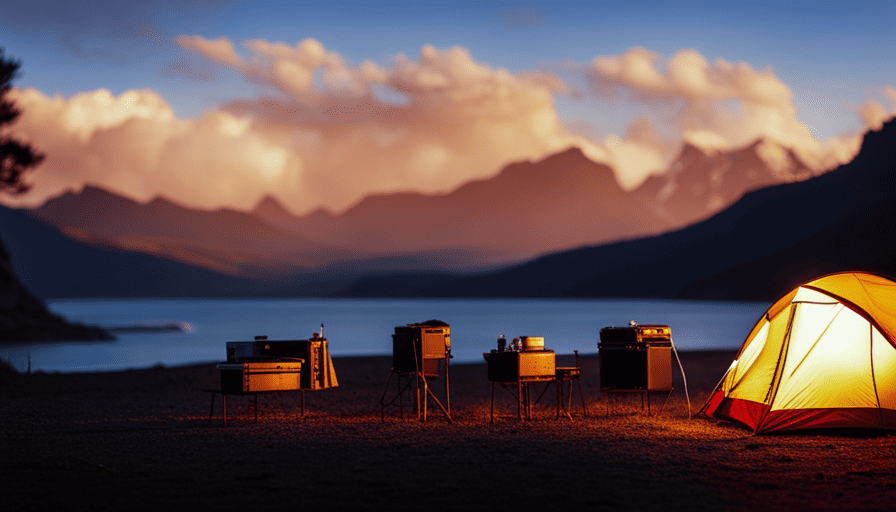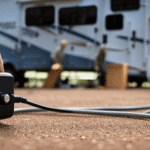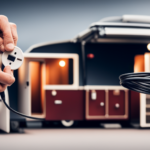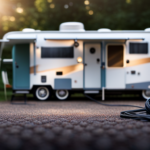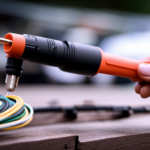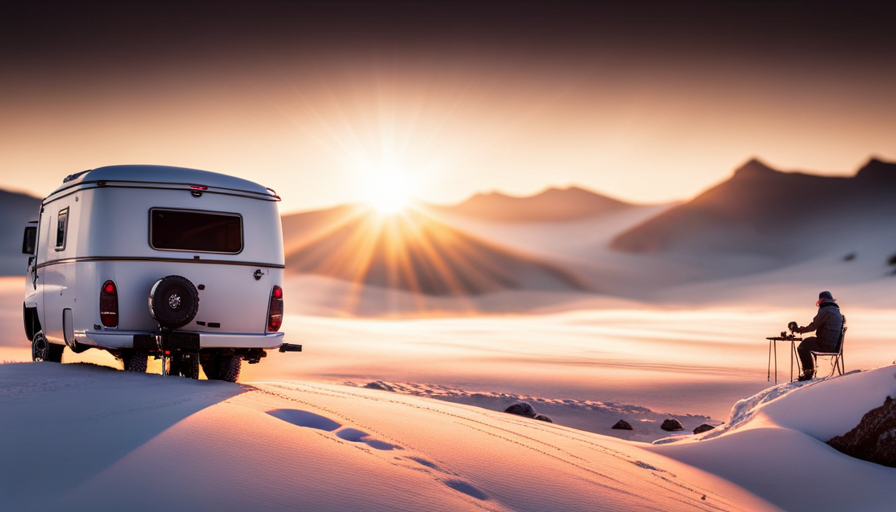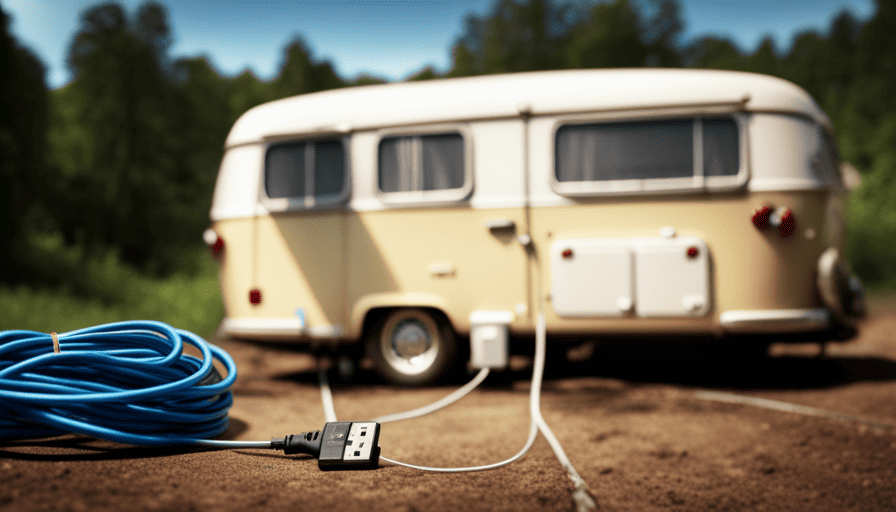Picture setting off on an adventure, with the vast road unfolding ahead like a limitless pathway of opportunity. Your reliable camper is hitched up, primed to offer both solace and protection as you venture into unknown territories. However, prior to embarking on your journey, there’s a crucial query to ponder: what is the maximum distance you can extend a 30 amp cord to electrify your camper?
This article will serve as your guide, offering technical insights and precise information to ensure a safe and efficient power connection. We’ll delve into the world of ampacity and voltage drop, explore the impact of environmental conditions, and discuss the use of extension cords and adapters.
Additionally, we’ll cover essential topics such as proper connection methods, regular maintenance, and the importance of backup power sources.
Whether you’re a seasoned traveler or a novice camper, understanding the limitations and considerations of running a 30 amp cord is crucial. So, let’s dive in and equip ourselves with the knowledge needed to embark on memorable adventures while staying safe and responsible.
Key Takeaways
- Understanding ampacity and voltage drop is crucial for determining the maximum distance a 30 amp cord can run to power a camper.
- The length and gauge of the cord are important factors in determining its maximum distance.
- Environmental conditions like extreme heat or cold can affect the performance of the cord.
- Properly connecting and securing the cord is crucial for safety and efficiency.
Understanding Ampacity and Voltage Drop
You’ll need to understand the concept of ampacity and voltage drop if you want to know how far you can run a 30 amp cord to your camper.
Ampacity refers to the maximum amount of current that a wire can safely carry. It is determined by factors such as the wire gauge, insulation type, and ambient temperature. To calculate the ampacity of a wire, you need to consider these factors and consult the National Electrical Code (NEC) or similar standards.
Voltage drop, on the other hand, refers to the decrease in voltage that occurs when current flows through a wire. It is important to keep the voltage drop within acceptable limits to ensure the proper functioning of your camper’s electrical system. To calculate the voltage drop, you need to know the length of the wire, the current flowing through it, and the wire resistance.
Once you have determined the ampacity and voltage drop, you can assess the length and gauge of the cord needed to safely power your camper. This involves considering the distance between the power source and the camper, as well as the gauge of the cord. By ensuring that the ampacity and voltage drop are within acceptable limits, you can determine the maximum distance that you can run a 30 amp cord to your camper.
Now let’s move on to assessing the length and gauge of the cord needed for your camper.
Assessing the Length and Gauge of the Cord
Assessing the length and gauge of the cord is crucial in determining the maximum distance the cord can extend to power the camper.
When it comes to assessing cord length, it’s important to consider the distance between the power source and the camper. The longer the cord, the higher the potential for voltage drop, which can lead to a decrease in the amount of power reaching the camper. To minimize voltage drop, it’s recommended to keep the cord length as short as possible.
Choosing the appropriate gauge of the cord is equally important. The gauge refers to the thickness of the wire and it directly affects the cord’s ability to carry the required amperage. For a 30 amp cord, a gauge of 10 or 8 is typically recommended. A thicker gauge wire has less resistance, which means it can carry more current without experiencing significant voltage drop.
Assessing cord length and choosing the appropriate gauge are essential steps in determining the maximum distance a 30 amp cord can be extended to power a camper. By keeping the cord length short and using the correct gauge, you can ensure that the camper receives the necessary power without experiencing voltage drop.
Now, let’s discuss how to factor in environmental conditions when determining the maximum distance.
Factoring in Environmental Conditions
Taking into account the weather and terrain conditions can greatly impact how far your 30 amp power cord can reach to provide electricity for your outdoor adventure. When factoring in temperature, it’s important to consider that extreme heat or cold can affect the performance of the cord.
High temperatures can cause the cord to overheat, potentially leading to a fire hazard. On the other hand, freezing temperatures can make the cord more brittle and susceptible to cracking, which can lead to electrical shorts. Therefore, it’s crucial to choose a cord that is designed to withstand the temperature range of your camping destination.
Another important factor to consider is the power needs of your camper. Different appliances and devices in your camper may require varying amounts of power. Before setting up your campsite, evaluate the power requirements of all your equipment. This will help you determine the appropriate length and gauge of the power cord needed to ensure efficient power delivery.
When determining the maximum distance your 30 amp power cord can reach, it’s essential to factor in the environmental conditions such as temperature and the power needs of your camper. By considering these factors, you can ensure a safe and reliable power supply for your outdoor adventure.
Now, let’s explore the next step of using extension cords and adapters to further extend your power reach.
Using Extension Cords and Adapters
To extend the reach of your power supply, have you considered using extension cords and adapters? These handy tools can provide the flexibility you need to connect your camper to a power source that may be farther away.
When using extension cords, it’s important to choose the right one for your needs. Look for cords that are specifically designed for outdoor use and are rated for the amperage of your camper.
Additionally, using power converters can help you manage power usage by converting the power from one source to match the requirements of your camper. This can be especially useful if you’re camping in a location with different power standards. However, it’s crucial to follow the manufacturer’s instructions and guidelines when using power converters to ensure safe and efficient operation.
With the right extension cords and adapters, combined with proper power management, you can maximize the reach of your power supply and enjoy your camper to the fullest.
Now let’s move on to the next section about properly connecting and securing the cord.
Properly Connecting and Securing the Cord
When connecting your power supply, make sure to securely fasten the cord, ensuring it’s tightly secured in place, so it doesn’t come loose and interrupt the flow of electricity. Properly connecting and securing the cord is crucial for the safety and efficiency of your camper’s electrical system.
Here are some key points to consider during the connecting process and to ensure cord safety:
- Use a high-quality, heavy-duty 30 amp cord that’s specifically designed for outdoor use.
- Inspect the cord for any signs of damage, such as cuts, frayed wires, or exposed insulation. Replace the cord if any issues are detected.
- Connect the cord to the camper’s electrical inlet by firmly pushing it in until it locks into place. Ensure that the connection is tight and secure.
- Use a weatherproof cover or a cord lock to protect the connection from moisture and prevent accidental disconnection.
- Keep the cord away from any sharp objects, hot surfaces, or areas prone to tripping hazards.
By following these steps, you can ensure a safe and reliable power supply for your camper. Now, let’s move on to monitoring power consumption to optimize your electrical usage.
Monitoring Power Consumption
Let’s dive into how we can keep an eye on our power usage to make the most of our electrical system. Power monitoring is crucial to ensure energy efficiency and prevent overloading. By monitoring our power consumption, we can make informed decisions about our electrical usage and optimize our energy efficiency.
To help us monitor our power usage, I recommend using a power monitoring device. This device measures the current flowing through the cord and provides real-time data on our energy consumption. With this information, we can identify any appliances or devices that are consuming excessive power and adjust accordingly.
To better understand the power consumption of our camper, let’s take a look at the following table:
| Appliance | Power Consumption (Watts) | Operating Time (hours) | Total Energy Used (kWh) |
|---|---|---|---|
| Air Conditioner | 1500 | 4 | 6 |
| Fridge | 200 | 24 | 4.8 |
| Lights | 60 | 8 | 0.48 |
| TV | 100 | 4 | 0.4 |
By regularly monitoring our power usage and making adjustments, we can ensure that we stay within the capacity of our 30 amp cord and avoid any potential issues. It’s important to remember that proper power monitoring goes hand in hand with regular maintenance and inspections to keep our electrical system running smoothly.
Regular Maintenance and Inspections
Regular maintenance and inspections are like giving your electrical system a tune-up, ensuring that all the gears are well-oiled and running smoothly to prevent any unexpected breakdowns or malfunctions. By regularly checking and maintaining your camper’s electrical system, you can ensure its efficient operation and promote electrical safety during your trips.
One important aspect of regular maintenance is inspecting all electrical connections and components for any signs of wear, damage, or loose connections. This includes checking the power cord, outlets, circuit breakers, and fuses. Any frayed wires or damaged components should be replaced immediately to prevent potential hazards.
Additionally, it is important to clean and lubricate all electrical connections to prevent corrosion and ensure optimal conductivity. This can be done using electrical contact cleaner and dielectric grease. Regularly inspecting and cleaning these connections will help prevent overheating and potential electrical fires.
Furthermore, it is crucial to test the electrical system regularly to ensure it’s functioning properly. This can be done using a multimeter to measure voltage, resistance, and continuity. Testing should be done at various points in the system, including at the power source, outlets, and appliances.
By conducting regular maintenance and inspections, you can greatly reduce the risk of electrical malfunctions and ensure the safety of your camper’s electrical system. Planning for backup power sources is another essential step in ensuring a reliable and uninterrupted power supply during your travels.
Planning for Backup Power Sources
When it comes to maintaining and inspecting your camper, regular check-ups are essential to ensure everything is in working order. However, even with diligent maintenance, unforeseen circumstances can arise, causing power outages during your camping trips. That’s why it’s crucial to plan for backup power sources to keep your camper running smoothly.
When considering backup power options, it’s important to calculate your power requirements accurately. This involves determining the total power consumption of your appliances and devices, as well as factoring in any additional power needs specific to your camper. By understanding your power requirements, you can choose the appropriate backup power source that will meet your needs.
To help you navigate this process, here are three key considerations to bear in mind:
-
Determine the wattage of your appliances and devices: Make a comprehensive list of everything you typically use in your camper and note their power ratings. This will enable you to calculate the total power consumption accurately.
-
Choose the right backup power source: Whether it’s a generator, solar panels, or an inverter, select a backup power source that can handle your power requirements and provide sufficient energy for your camping needs.
-
Assess the available fuel or energy sources: Consider the availability of fuel or energy sources for your backup power option. This will ensure you can replenish your power source as needed, keeping your camper operational.
By carefully considering these factors, you can confidently choose the most suitable backup power source for your camper. However, it’s important to remember that seeking professional advice and assistance is always wise to ensure the safety and efficiency of your backup power system.
Seeking Professional Advice and Assistance
Seeking professional advice and assistance is always a wise choice to ensure the safety, efficiency, and proper functioning of your backup power system in your camper. When it comes to installing and maintaining electrical systems, it’s crucial to rely on experts who can provide professional recommendations based on their knowledge and experience.
They can assess your specific needs and make sure that your backup power source is compatible with your camper’s electrical system.
Professional electricians can also help troubleshoot any issues that may arise with your backup power system. They have the expertise to identify and fix problems efficiently, saving you time and frustration. Whether it’s a faulty connection, a malfunctioning component, or an overload, they can diagnose the issue and provide effective solutions.
Additionally, seeking professional assistance can help you navigate through the complexities of electrical codes and regulations. They can ensure that your backup power system meets all safety standards and is installed correctly. This is crucial to avoid potential hazards and ensure the long-term functionality of your camper’s electrical system.
In the next section about staying safe and responsible, we’ll discuss some important guidelines to follow when using your backup power system.
Staying Safe and Responsible
When it comes to staying safe and responsible while camping, there are two key points to keep in mind.nnFirst, it’s crucial to follow safety guidelines and regulations to ensure the well-being of yourself and others. This includes properly setting up and maintaining your campsite, using equipment correctly, and being aware of any potential hazards.
Additionally, being mindful of others and the environment is essential. This means respecting quiet hours, properly disposing of trash, and leaving the campsite as you found it.
By following these guidelines, we can all enjoy a safe and responsible camping experience.
Following safety guidelines and regulations
To ensure safety and comply with regulations, you can extend a 30 amp cord to your camper without compromising electrical standards. However, it is crucial to understand the electrical capacity of your camper and consider your power needs before extending the cord.
The length of the cord should match the distance required. Excessive lengths can result in voltage drop and potential overheating. It’s recommended to use a high-quality cord specifically designed for outdoor use and rated for 30 amps.
Also, it’s essential to avoid overloading the circuit by plugging in multiple appliances simultaneously. By following these guidelines, you can safely extend your 30 amp cord and provide adequate power to your camper.
Being mindful of others and the environment while camping includes adhering to electrical safety standards and using energy responsibly.
Being mindful of others and the environment while camping
Being considerate of fellow campers and the natural surroundings involves practicing eco-friendly habits and respecting quiet hours. To minimize noise and disturbances while camping, here are three key strategies to follow:
-
Choose a campsite away from high-traffic areas and popular gathering spots to reduce noise levels and disturbances.
-
Use low-noise equipment and minimize the use of generators during quiet hours to respect the peace and tranquility of the campground.
-
Dispose of waste properly by following campground guidelines and using designated recycling and trash bins, preventing environmental pollution and promoting cleanliness.
By being mindful of others and the environment, we can create a harmonious camping experience for everyone. Remember, the goal is to enjoy nature while minimizing our impact and respecting the peace and quiet that camping offers. So let’s be considerate campers and take steps to minimize noise and disturbances, preserving the serenity of the great outdoors.
Frequently Asked Questions
Can I use a 30 amp cord for a camper that requires a higher amperage?
No, a 30 amp cord can’t handle the power demands of a high amperage camper. Using a lower amperage cord for a higher amperage camper poses significant risks. The cord may overheat due to the excessive current, leading to potential electrical fires and damage to both the cord and the camper’s electrical system. It’s crucial to use the appropriate cord with the correct amperage rating to ensure safe and reliable power supply to the camper.
What is the maximum length of a 30 amp cord that can safely be used for a camper?
The maximum length of a 30 amp cord that can be safely used for a camper depends on various factors. It’s crucial to consider the amperage requirements of the camper and the gauge of the cord.
Generally, a 30 amp cord can safely reach distances up to 30-50 feet. However, it’s important to ensure that the cord isn’t overloaded and that it can handle the electrical load without overheating or causing any safety hazards.
Can I use a 30 amp extension cord to connect my camper to a power source?
Yes, you can use a 30 amp extension cord to connect your camper to a power source. However, there are limitations to using a 30 amp cord for a camper. The length of the cord should be kept as short as possible to minimize voltage drop and prevent overheating. If a longer distance is required, it’s recommended to use a heavier gauge cord or consider alternatives to using a 30 amp extension cord for connecting a camper to a power source, such as installing a dedicated RV outlet.
How often should I inspect and maintain my 30 amp cord for my camper?
Inspecting and maintaining your 30 amp cord for your camper is crucial for safety and optimal performance. To ensure its longevity, it’s recommended to inspect it annually, or more frequently if it’s frequently used or exposed to harsh conditions.
Signs of a damaged cord include frayed or exposed wires, melted insulation, or loose connections. Replace your cord immediately if any of these signs are present to prevent potential hazards and ensure uninterrupted power supply.
What are some safety precautions to keep in mind when using a 30 amp cord for a camper?
When using a 30 amp cord for a camper, it’s crucial to prioritize safety. To ensure proper grounding, always use a properly wired and grounded electrical outlet.
Regularly inspect and maintain the cord to identify any frayed wires or damage that could pose a safety risk.
Additionally, make sure to follow manufacturer guidelines and avoid overloading the cord with excessive electrical appliances.
By following these safety tips, you can minimize the risk of electrical accidents and ensure a safe camping experience.
Conclusion
In conclusion, ensuring a safe and efficient power connection to your camper is essential for a successful outdoor adventure. By understanding ampacity and voltage drop, assessing the length and gauge of your cord, factoring in environmental conditions, using proper extension cords and adapters, and regularly maintaining and inspecting your equipment, you can enjoy a worry-free camping experience.
Planning for backup power sources and seeking professional advice when needed will further enhance your camping trip. So, plug in your 30 amp cord and embark on an electrifying journey amidst nature’s embrace.

